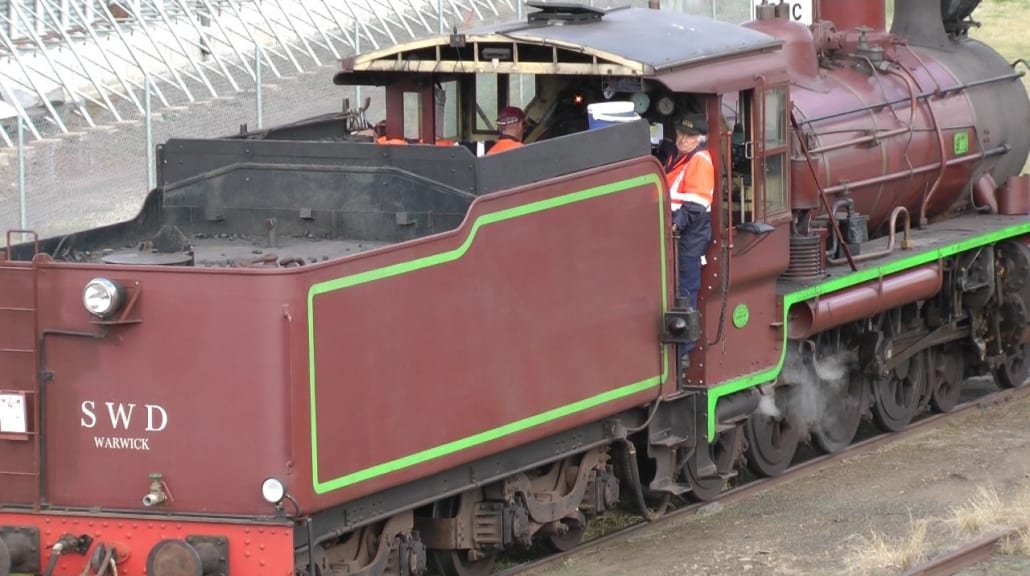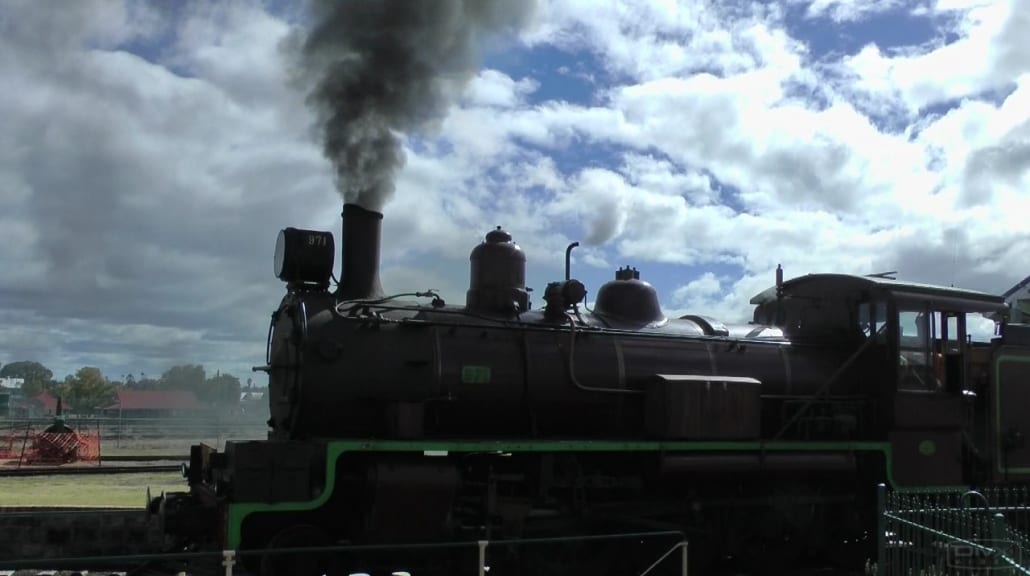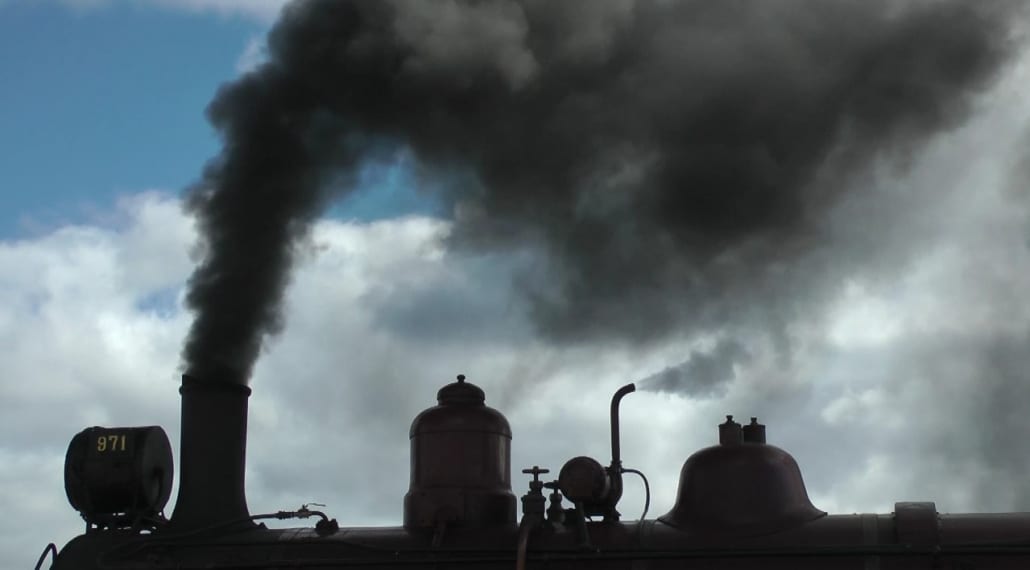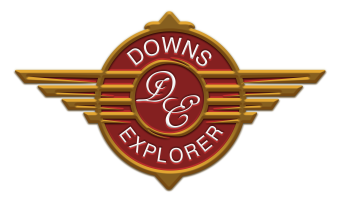Current status: 100% restored / Mainline Operational
Built: 1950
Retired: 1969
Type: C17
Weight: 56.8t (when empty) 82.9t (when full)
Length: 16.3m
Width: 2.620m
Height: 3.8m
Boiler pressure: 7,206kPa
Tractive effort: 93.4kN
Coal: 8.13t
Water: 13,865 l
Driving wheels: 1.14m in diameter
Grate area: 1.719 sqm
Valve gear: Walschaerts
Gauge: 1,065 mm gauge (3ft 6in)
Winner of ATHRA Locomotive Restoration Award 2007
History of C17 Class
After the Second World War, forty of these locomotives were built by Walkers Limited, of Maryborough. These locomotives were an important part of the major rehabilitation and reconstruction of the Queensland Railways in the post war period. The new locomotives followed on an improved design introduced in 1938.
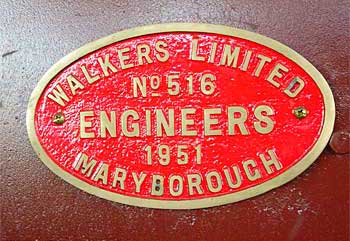
Builder plate on C17 971 in the roundhouse at Warwick.
The Walkers Ltd engines were all painted in a medium brown colour scheme with green lining on the footboards, and tender edge, and black smoke box and red buffer beams. The engines were nicknamed ‘Brown Bombers’ after the then world champion heavyweight boxer Joe Louis. These brown bombers differed because they were fitted with roller bearings and larger tenders. Also, a more streamlined cab and side windows for weather protection were fitted.
The workhorse of the steam era, the C17 locomotive being overall the most numerous class of Queensland engine, was also possibly the most versatile.
The C17 worked almost any train in Queensland, be it suburban passenger, goods train shunt or even hauling air-conditioned trains in western Queensland.
The main reason so many of this class were constructed was that it was the most powerful form of conventional locomotive that could run on Queensland tracks, regardless of the limitations of axle loading.
Sadly with diesels becoming more popular, the C17 Class started to be withdrawn, with No. 261 first on 21st October 1952. There were at least 119 C17’s still on the books on 31st December, 1969 however, within a year, the last 6 C17’s were condemned on 26th August, 1970, with QR now fully dieselised.
The C17 Class lasted 50 years from 1920 to 1970. And proved to be the most powerful all lines engine in Queensland.
History of C17 971
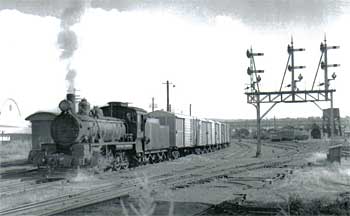
C17 971 on Amien goods train 134 from Warwick in the 1960’s.
The locomotive was well known to the Warwick locals for being used regulary on the Dirranbandi (Thallon) Mail when working from Warwick, and Toowoomba Depots.
During it’s lifetime 971 was based at many depots, some of which were:
- Toowoomba in November 1950
- Roma in October 1954
- Toowomba in September 1955
- Mayne in Ocober 1956
- Toowoomba in December 1956
- Warwick in April 1966
- Toowoomba in January 1967
Some duties that No.971 was noted to have performed are:
- 23 October 1964 – No. 124 Goods Warwick to Wallangarra, detaching at Wyberba, Glen Aplin, Stanthorpe, Applethorpe, Thulimbah, Cotton Vale and Fletcher. Departed Warwick 1.35 pm and arrive Wallan-garra at 7.35 pm.
- 24 October 1964 – No. 551 Goods. Departed Wallan-garra at 7.15 am with guards van No. 970. Picked up a wagon at Stanthorpe, arrived Warwick at 12.42 pm.
- 13 December 1966 – No. 192 Texas Goods. Departed Warwick at 8.00 am with Guards van No. 1547, and 4 wagons. It crossed Train 649 at Gore. Arrived Inglewood 2.08pm, and with a crew change, would have shunted and proceeded onto Texas, returning later that evening
- 13/14 December 1966 – No. 183 Goods. Departed Inglewood at 11:40 pm with guards van No. 1547, and 11 wagons. Crossed 674 at Cunningham brfore arriving at Warwick at 4:57am
971 was retired from service in February 1969 and was donated to the Chinchilla Historial Society where it remained until May 2000 when the SDSR brought her back to Warwick.
Restoration of 971
C17 971 was acquired in May 2000 from Chinchilla Historical Society. It was lifted by 2 50t Cranes on 2 low loaders, and transported by road to Warwick, where it was unloaded. After arrival, a meticulous inspection was undertaken followed by complete strip down and cataloging of all components. The tender was found to be fair on initial examination, and although almost all brass and copper parts were missing, the locomotive itself seemed to be in reasonable condition. It had no roof, gauges, pipe work, or injectors, but still retained most of it’s major control levers, such as reversing, cylinder and blow downs cocks. Most importantly, all the Walschaert Valve gear was intact.
Work commenced on the stripping of the locomotive for complete overhaul and restoration in July 2000. For the next 3 years, the process of stripping and cataloging the locomotive was undertaken. Fund raising with the capacity of providing sufficient funds to purchase and install a brand new boiler and the refurbishment of running gear (pistons, sleeves, bearings) also occurred during this time. It was SDSR’s goal to fully restore this locomotive back to original running condition capable of providing a regular tourist train service for the Darling Downs and Granite Belt.
The progress of work through this was to remove all fittings to allow access and removal of the boiler. First to go was the cab, and was followed by boiler cladding, funnel, and most of the valve gear. This process took some time, but eventually the boiler was ready to be removed.
SDSR encountered initial problems removing the saddle bolts, with some having to be cut out, and fire bars needing to be removed. Once complete the boiler was removed by 30t crane, and taken to a local company for sandblasting. The detailed examinations of the boiler were undertaken, and found the boiler to be in bad condition in places. It was decided that it would be more cost effective to order a new boiler, which was delivered to SDSR on 5th July, 2004.
Once the old boiler was removed, work continued on the stripping of the locomotive, with the goal being to get the wheels out for inspection and the frame rady for sand blassting. Using timber stays, the locomotive frame was jacked over 4 feet, to allow the wheels to be rolled out. The wheels were inspected, and where required, roller bearings were replaced. This process took several months, and throughout this time, work had slowly being continued cleaning and painting of the various parts that had been removed.
By this time, a group of up to 10 retired gentlemen formed themselves “Dad’s Army”, and ably led by ex QR Fitter John Brady, completed most of the restoration progress.
With the boiler on order, the frame was inspected and sand blasted, and work began in early 2004 to start to rebuild the locomotive. Firstly, the wheels were re-inserted, and the frame, after being on a flat wagon for over 6 months, was finally replaced. Springs were inspected and found to be in good condition, and the brake rigging was restored. The ashpan was repaired, and the ashpan doors were re-fitted.
The new boiler was fitted July 2004, and work continued to restore the locomotive.
New boiler cladding was fitted, with new insulation, and the cab was readied to be placed back on the frame. Once back on, work commenced on the many parts required for the cab, and the new steel roof was constructed and fitted.
SDSR needed an exhaustive list of parts to be sourced, which included;
Whistle, gauge glasses, air gauges, cab glass, injectors, Westinghouse air pipes, Steam pipes, Lubricator and numerous associated components.
The steam and Westinghouse pipes were all designed, fabricated and fitted on site. This process took many months, and was not fully completed until March 2007, when the locomotive was fired up for the Open Day. Many years of work had gone into the project, and the movement of the locomotive of the Open Day was a huge successful event.
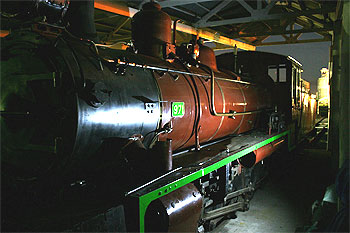
C17 971 awating first duties at the Warwick Loco Roundhouse. Photo: A. Cole, 6 Jan 2007.
Work was finally completed in July 2007, with the electrical and lighting work being completed to registration requirements being the last stage.
SDSR members have put countless hours of work into the restoration with members of “Dad’s Army” having committed a minimum of 2 working days per week per person for the past several years.
The mamoth task of registration and accrediation for C17 971 and SDSR to run on the QR Network fiannly saw fruition in December 2008.
On 13 December, C17 971 entered the QR Network for it trials, running to Morgan Park Light engine, and that afternoon to Toolburra (with 2 carriages).
The nexct day, this same train conducted member training with a trip 2 trips to Hendon.
Now that C17 971 is mainline operational, it forms the “jewel in the crown” of SDSR’s Tourist train services being run out of Warwick for many years to come.
More Images
